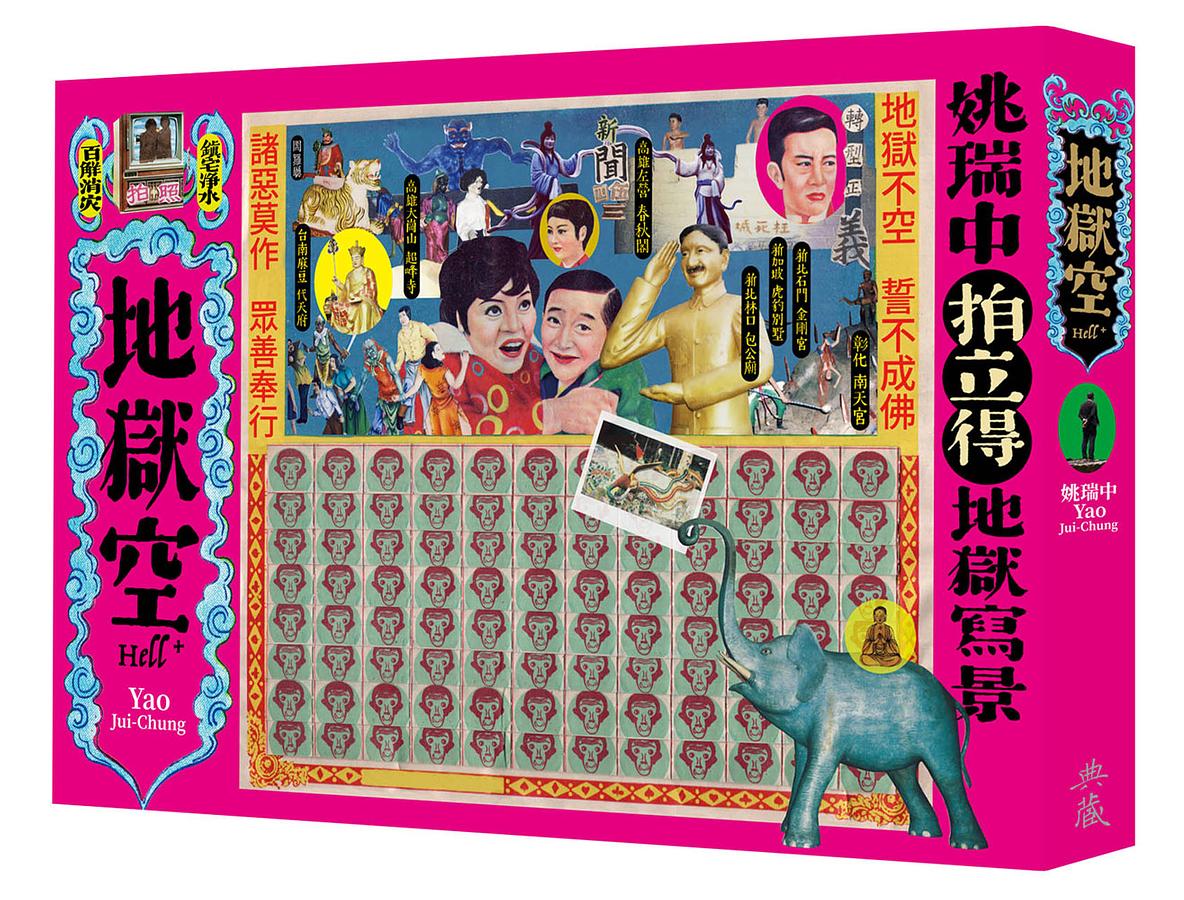地獄空: 姚瑞中拍立得地獄寫景
| 作者 | 姚瑞中 |
|---|---|
| 出版社 | 聯灃書報社有限公司 |
| 商品描述 | 地獄空: 姚瑞中拍立得地獄寫景:地獄不空,誓不成佛。地獄在哪裡?「地獄空」系列,是藝術家姚瑞中近年走訪全台設有地獄場景宮廟並探究台灣信仰的拍攝計畫。「試著讓天堂拍 |

| 作者 | 姚瑞中 |
|---|---|
| 出版社 | 聯灃書報社有限公司 |
| 商品描述 | 地獄空: 姚瑞中拍立得地獄寫景:地獄不空,誓不成佛。地獄在哪裡?「地獄空」系列,是藝術家姚瑞中近年走訪全台設有地獄場景宮廟並探究台灣信仰的拍攝計畫。「試著讓天堂拍 |
內容簡介 地獄不空,誓不成佛。 地獄在哪裡? 「地獄空」系列,是藝術家姚瑞中近年走訪全台設有地獄場景宮廟並探究台灣信仰的拍攝計畫。「試著讓天堂拍得像地獄,地獄拍得像天堂。」以拍立得拍攝多處以道教或佛道混合信仰為主的地獄審判場景,這些場景沒有西方與東方的古典雕塑感,具有乖張奇異與扭捏可愛的獨特台灣美感。 全書採多種紙張材質與色彩鋪陳空間層次,滲入社會與時代與人文之氛圍糾葛,並收錄藝術家二位高徒-道士陳柏瑜恭繪之插畫與符咒以及信士蔡浚勝恭印之木刻版畫,書籍三邊刷金,與洋紅色的台風拼貼封面共同包覆且顯形時空裡的劇目遺跡。在過曝脫焦、即時顯影的拍立得顯相下,更具迷離奇幻,人界心間見地獄。如姚瑞中言:「地獄本空,唯妄念生起一切羨慕嫉妒恨而地獄現前。」
作者介紹 姚瑞中姚瑞中(YAO Jui-Chung)1969年生於台灣台北,1994年國立台北藝術大學美術系畢業。曾受邀參加威尼斯雙年展、橫濱三年展、布里斯班亞太三年展、上海雙年展、首爾媒體城市雙年展、曼徹斯特亞洲藝術三年展、深圳雕塑雙年展、亞洲雙年展、雪梨雙年展、台北雙年展...。1992年獲台北攝影新人獎,2013年獲香港集群藝術獎,2014年獲新加坡亞太藝術獎,北藝大傑出校友,2018年獲台新獎。著有《台灣裝置藝術》、《台灣當代攝影新潮流》、《台灣廢墟迷走》、《台灣行為藝術檔案》、《流浪在前衛的國度》、《廢島》、《姚瑞中》、《人外人》、《幽暗微光》、《逛前衛》(合著)、《恨纏綿》、《萬歲山水》、《萬萬歲》、《小幻影》、《海市蜃樓一至七輯暨英文版》(編著)、《攝影訪談輯一至三輯》(主編)、《巨神連線》等書,2020年台灣雙年展策展人。目前為國立台灣師範大學美術系兼任副教授,幻影堂堂主。
| 書名 / | 地獄空: 姚瑞中拍立得地獄寫景 |
|---|---|
| 作者 / | 姚瑞中 |
| 簡介 / | 地獄空: 姚瑞中拍立得地獄寫景:地獄不空,誓不成佛。地獄在哪裡?「地獄空」系列,是藝術家姚瑞中近年走訪全台設有地獄場景宮廟並探究台灣信仰的拍攝計畫。「試著讓天堂拍 |
| 出版社 / | 聯灃書報社有限公司 |
| ISBN13 / | 9789579057998 |
| ISBN10 / | 9579057990 |
| EAN / | 9789579057998 |
| 誠品26碼 / | 2682048213000 |
| 頁數 / | 264 |
| 注音版 / | 否 |
| 裝訂 / | P:平裝 |
| 語言 / | 94:中 英對照 |
| 尺寸 / | 21X14.8CM |
| 級別 / | N:無 |
內文 : 地獄空Hell+
-
拍立得(寶麗來)Polaroid
2018~2021
「地獄空」系列是近年走訪全台設有地獄場景宮廟並探究台灣信仰的拍攝計畫。「試著讓天堂拍得像地獄,地獄拍得像天堂。」此拍攝計畫包括台灣數個具有地獄造景、壁畫與受難圖像的宮廟或公園,拍攝多尊以道教或佛道混合信仰為主的地獄審判場景,這些雕像特別之處在於沒有西方與東方的古典雕塑感,具有乖張奇異與扭捏可愛的獨特台灣美感。
縱貫全台灣主要踏查地點包括新北市石門區金剛宮、林口區青嶺湖北文紫祥宮包公廟、彰化市南天宮、台南市麻豆代天府、嘉義縣水上鄉白人牙膏觀光工廠、高雄市阿蓮區大崗山超峰寺、高雄市左營區東南帝闕樂善社啟明堂春秋閣…等地點,也收錄了新加坡虎豹別墅。以如同田野調查般藝術概念與帶有疏離感的觀看方式,詮釋漢人常民文化中的在地美學。拍攝時以廣角大型拍立得的正面閃光與脫焦效果、化學斑點、即時顯影、發色不正常、晃動模糊、構圖歪斜、洩光……等手法,造成宛若「觀落陰」到此一遊的現場見證照,凸顯台灣民間信仰對於地獄想像的常民文化詮釋。
之所以用「地獄空」作為作品名稱,只因貪、瞋、痴、慢、疑畢竟難以根除,墮入永劫輪迴乃業障未除,過度執著外相乃至迷戀色身而錯失妙明本心,地獄自然永不空乏,地藏菩薩更永無成佛之日。若能明心見性,照見究竟空性,宛若明鏡映照塵埃,微塵卻不落鏡中,無論是極樂天堂還是無間地獄,皆來自一念之間。
Hell+
-
Polaroid
2018~2021
The Hell + series is a recent photographic project of Yao Jui-Chung. Yao takes a long time to visit temples around Taiwan and investigates Taiwan’s traditional beliefs. The artist tries to “make heaven like hell and hell like heaven” through his lens. For this project, Yao has been to temples or parks that feature scenes from a Taoist or Buddhist-Taoist hell with animatronic dioramas, hellish murals and images of people suffering. He photographed statues and animatronics found in these dioramas. Instead of presenting the traditional aesthetics of classical sculptures, these statues and animatronics embody an eerie beauty and quirky loveliness of Taiwan’s particular aesthetics.
Throughout Taiwan, Yao has visited the following temples and venues: Jingang Temple in Shimen District and Baogong Temple in Linkou District, New Taipei City, Nantian Temple in Changhua, Madou Daitian Temple in Tainan, Whiteman Toothpaste Tourism Factory in Shuishang Township, Chiayi, Dagangshan Chaofeng Temple in Alian District and the Spring and Autumn Pavilions of Chi Ming Palace in Zuoying District, Kaohsiung. The Haw Par Villa in Singapore is also included in this project. Yao interprets the aesthetic of Han Chinese folk culture with his field-research-like artistic approach and a detached way of viewing. Yao took the photographs with a wide-angle Polaroid with effects such as flash and out-of-focus effect, chemical stains, instantly-developing, uneven coloring, blurring, tilted horizons, and light leak effect, creating a testimony of “Guan-luo-ying” (séance). This project highlights how folk culture and beliefs shape and interpret the image of hell.
Kṣitigarbha, a bodhisattva revered in East Asian Buddhism, once made a vow not to attain Buddhahood until the hell is emptied. Yao takes “Hell +” as the title of his work since the five poisonous qualities, attachment, anger, ignorance, pride and jealousy are difficult to eradicate. If one falls into eternal reincarnation, it is because their karmic hindrance hasn’t been removed. When one is overly attached to the external appearance or obsessed with the physical body and misses one’s buddha nature, they will never get rid of falling into hell. Therefore, Kṣitigarbha will never achieve Buddhahood. If one could behold his buddha-nature with an enlightened mind, one will come to understand the ultimate voidness. Just like a clear mirror reflects the dust; however, the dust does not fall into the mirror. Whether it’s blissful heaven or infernal hell, all conditions are only shaped by a single thought.
最佳賣點 : 新書推薦